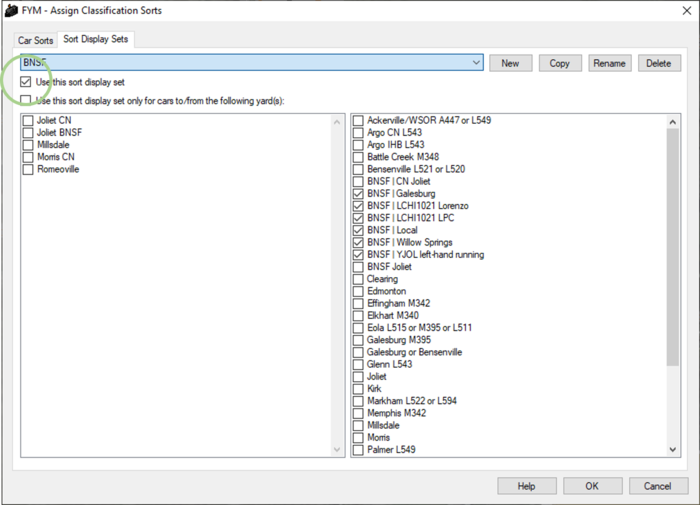Defining Sorts and Assigning to Classification Tracks
Defining Sorts
The default and most powerful sorting tool in FYM is the shift-3/4/5 filter, in which you define custom sorts for each map. You can even create multiple custom sets of these sorts for various purposes, such as sorting for multiple different railroads on a single map (multiple-identity map).
In map, press 9 (keyboard top row) to access the "Assign Sorts and Tracks" window. If you are in a map that has a classification hump, you must define the hump tracks before this dialogue is accessible.
To assign destinations to sorts, use the tools on the right-hand side. Sorts may contain:
1. Specials (bad order or wash)
2. Specific yard
3. RR and empty
4. RR and state
5. RR and <Any> state
6. State
7. Car type (i.e., any car of this type will be classified into this sort)
Autoracks and Intermodal Cars
You can control how autoracks and intermodal cars are displayed (colored):
Shift/3: autorack color defined by autorack-specific filters (shift-A), intermodal color defined by intermodal-specific filters (shift-I)
Shift/4: autorack color defined by main sort logic (bypass shift-A)
Shift/5: autorack and intermodal color defined by main sort logic (bypass shift-A and shift-I)
Autoracks and intermodal flatcars are only tested against criteria 2 and 7 when going over a hump. Multi-platform cars of any type cannot be humped.
Assigning Sorts to Tracks in a Hump Yard
Select the "Hump Tracks" tab, choose the hump you want to edit, and use the drop-downs to choose sorts to assign to each track. You can assign multiple sorts to each track. Sorts assigned to multiple tracks are sent by the hump to the first non-locked-out track that matches the sort of the car going over the hump.
Defining and Using Sort Display Sets
You can force the filter to display colors according to only a subset of sorts. This feature is useful for multiple-identity maps because sort logic is rarely the same for all identities.


